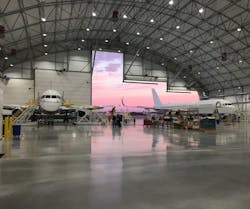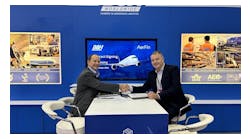Last December AMT attended the grand opening ceremony for AAR’s newest airframe MRO facility located on the Chicago Rockford International Airport (RFD) in northern Illinois. The two massive side-by-side hangars were impressive. The 238,000-square-foot facility consists of two 10-story hangars each measuring 300 feet by 300 feet with common areas between them for offices, tool and equipment rooms, work control centers, and employee break rooms. The hangars are capable of holding the largest wide-body airliners.
Aircraft maintenance work is ramping up and AAR is currently conducting work for a tier-one airline and, previous to its arrival, completed work for a large cargo carrier. Additionally it has a line of work scheduled for the next several months.
At the time of the grand opening there was a core group of around a dozen employees assigned to the new facility, and at the time this article was written that number was up to about 50.
THE ROCKFORD APPEAL
Needless to say there’s a lot of excitement and proud people associated with this facility. During the opening ceremony, David Storch, AAR's chairman, president and chief executive officer, remarked, "I'd be very disappointed if, at the end of the day, this was not a premier maintenance operation. The possibilities of being here in Rockford, I think, far outweigh the benefits we have elsewhere around the country."
Wayne Jamroz is AAR’s general manager of the new Rockford facility and proudly commented for this article, "The city, businesses, and people of Rockford have built one of the finest MRO facilities in the country. The experience thus far has been nothing short of amazing. We understand the attention that goes along with this, as well as the responsibility that has been bestowed upon us to make this facility as successful and supportive to the community as we can. We are working day in and day out to capture the right work and to build our reputation here as the premier wide-body maintenance facility in the country and hopefully the world. We are putting together a world class team in an effort to achieve these goals. As I have said to our new employees, this is the beginning of something Great!”
There are a few reasons that made Rockford an ideal location for AAR to open its newest MRO. Rockford has a history of aerospace connections and companies located there, and building the new MRO has reinforced the area's connection with the aviation industry. Troy Jonas, vice president of MRO Services, says, “The airport authority, along with state and local government, was instrumental in working with us and building a state-of-the-art facility in this area not far from Chicago.” AAR’s headquarters is located near Chicago.
WORK AND WORKFORCE PROJECTIONS
When asked about the plans for work at the new location Jonas describes a potential blend of narrow and wide-body aircraft heavy checks. “We are focused on wide-body aircraft, however, with the large capacity available to us, we could also add in several narrow-body aircraft along with wide-body aircraft.” He goes on to say, “The facility can accommodate two Boeing 747s, eight Boeing 737-800s, or four Boeing 787s. The station can even hangar the new double-deck, wide-body, four-engine Airbus A380. We expect at full capacity to see 750,000 to 1 million man-hours of work per year.”
When asked about AAR’s projections for heavy maintenance work over the next five to 10 years Jonas says, “AAR anticipates low single-digit growth within North America and high single-digit growth outside the United States, particularly in Asia. We anticipate a mix of U.S.-based and foreign carriers, and we do expect some wide-body work to shift back into the U.S. from overseas. With the largest and leading network of MRO facilities in the U.S., AAR is well-positioned to meet this increased demand with American workers.”
Jonas closes by saying, “We feel good about the opportunities we are seeing to bring in additional customers to the Rockford facility.”
Greg Dellinger, director of talent for AAR states, “This is a brand new facility designed for next generation aircraft. Any aircraft maintenance professional would want their resume to show they spent time here.” Hiring of course is directly tied to maintenance inputs, but the goal is to have between 300 and 500 employees at this facility in three to five years. With multiple locations in its MRO network, AAR has the ability to shift interested employees from one location to another.
A UNIQUE BUILDING
Rubb Building Systems was selected to build the facility. The steel truss framework is clad with 2-inch thick insulated fabric which has some unique properties. Sean Hickey with Rubb says, “Our PVC-coated, polyester-based membrane, used to clad the hangar roofs, has certain fire safety advantages. It meets NFPA 701 and ASTM E-84 for flame retardancy. This essentially means that if a fire is to occur, the membrane will not propagate flames.”
Hickey goes on to explain that if a fire does occur, the fabric in that area will “self-vent,” allowing the interior of the structure to remain cool enough for firefighters to perform their duties, and the structural frame never gets hot enough for the steel to be damaged.
Because of the self-venting and compliance with the NFPA and ASTM standards, the fire safety code for hangars, NFPA 409, was revised in 2011 to look favorably on membrane clad hangars. Membrane clad hangars fall into Group IV classification, meaning they can have an unlimited fire area and only need a foam protection system. Most conventional buildings are limited in fire area and require both sprinklers and foam.
The membrane roof also has other advantages over conventional building materials in terms of faster initial construction, lower lifetime maintenance, and being more energy efficient.
The hangar doors are just as interesting. The ASSA ABLOY Entrance Systems Megadoor is the modern alternative to the older traditional bottom rolling doors. The AAR team first utilized Megadoors on another massive hangar they leased from the Chennault Airport in Louisiana.
Pierre Varlamoff with ASSA ABLOY Entrance Systems says, “One of the goals when designing a cost-effective and efficient hangar facility is to maximize operational flexibility while minimizing the hangar square footage and volume. Since, Megadoors lift vertically, the door system can be shaped to the aircraft mix, and they do not require the massive door pockets and track system of conventional bottom rolling doors, saving thousands of square feet of room.”
Varlamoff says, “The door is comprised of horizontal aluminum beams that are skinned on the interior and exterior with a PVC-coated polyester fabric which envelopes the side guides. Our unique seals provide exceptionally low air infiltration rates dramatically reducing energy loss in the cold Rockford winters. The translucent white fabric of the door allows natural light into the hangar providing a safer, happier, and more productive work environment for the aircraft technicians.”




